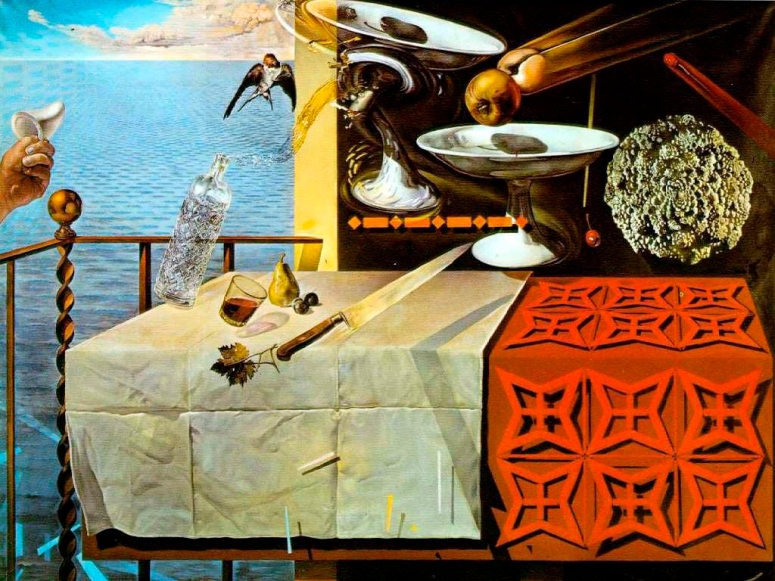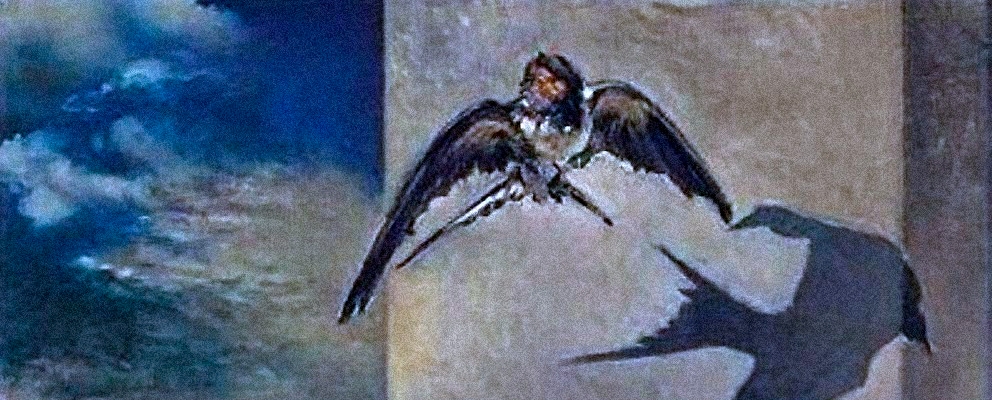Widely, and perhaps best, known in French as L’Hirondelle immobile, this small and delicate oil seems to be a previous partial study for a bigger painting, undeservedly much more famous, that Salvador Dalí made in 1956. It is not at all a sketch, like one can read in several well-known art sites and galleries online, but a fully worked, finished and accomplished work. As a matter of fact, everything depicted in it (the swallow, its shadow, the wall, the cloudy sky, the sea –so still and lugubrious; frozen as the bird–, the balcony railing with its incongruent shadow) is to me way more suggestive than its translation to the larger painting, also shown below. (I opine it could even be a simultaneous work, or even a posterior one; not really complementary, but independent of it.)
This is certainly one among my preferred paintings by the artist: subtle, insidiously puzzling, gradually disquieting… Surrealism at its purest.
–

[Private Collection]
–
The swallow becomes almost accessory in “Natura Morta Vivent” (Living Still Life); it is also awkwardly positioned; it casts no shadow… it is not still, but imposed; dissected or, even worse: fake.
The best in this work are the carved bottle of anis and the knive in the very centre of the canvas (quite menacing; frightening to me). The phony fast-moving apple behind the actual apple, might be just a penis (and not the only one insinuated or allegorized here) –hence the knive, in agreement with Dalí’s darker obsessions (*)–. (Let me point out here that I have nothing against penises; on the contrary; I just dislike knives near them!)
Also, the table might not be just a table, but an altar, and a sacrificial one; and… is that apparent cauliflower at the right hand side a sponge to wash the blood to come?
–

[The Salvador Dalí Museum, St. Petersburg (Florida, USA)]
–
Both illustrations come from “SALVADOR DALÍ. Catàleg raonat de pintures (1910-1964)” (a really good work in progress, indispensable for anyone interested in the Catalan painter and/or seeking reliable information about his paintings). — I have slightly rectified the tones and contrast of the first one to amend the dubious rendering shown in the said web, and trying to follow the printed documentation available when the work was publicly last shown: London in June 2002, when auctioned at Sotheby’s.
(*) About the artist’s mental issues and, especially, his fear of castration along with his cruelty and sadomasochistic trends, you may read some additional comments on my post: “A detailed ‘Soft Monster in Angelic Landscape’ (Monstre Tou en Paisatge Angèlic), by Salvador Dalí i Domènech”
No unauthorised copying or redistribution.

I admit I’ve never considered myself an art “expert,” but Dali has always created some nice masterpieces…..
LikeLiked by 2 people
That’s true, John. He was a big disaster (and a complete asshole) as a person, but a great artist, most especially in his middle period. Afterwards, he succumbed to commercialism and to his avidness for easy money.
Thanks a lot for stopping here as always, brother, and take my heartfelt hugs and very best wishes !!
LikeLiked by 1 person
Unfortunately commercialism in art has been evident for much longer than we may realize…..always a pleasure, sis….big hugs and best wishes back to you!!!!!
LikeLiked by 1 person
A truly interesting point of view, as always. The “Natura Morta Vivent” is quite scary and sinister to me, particularly when having read the alternative title…
LikeLiked by 1 person
Thank you very much, sweety 💐 ✨ ! I think all what he painted (or most of it) is quite scary when rightly understood. He had much talent, but his spirit was somewhat sick (not just his mind…). *Hug and nose boops* 🙂
LikeLike